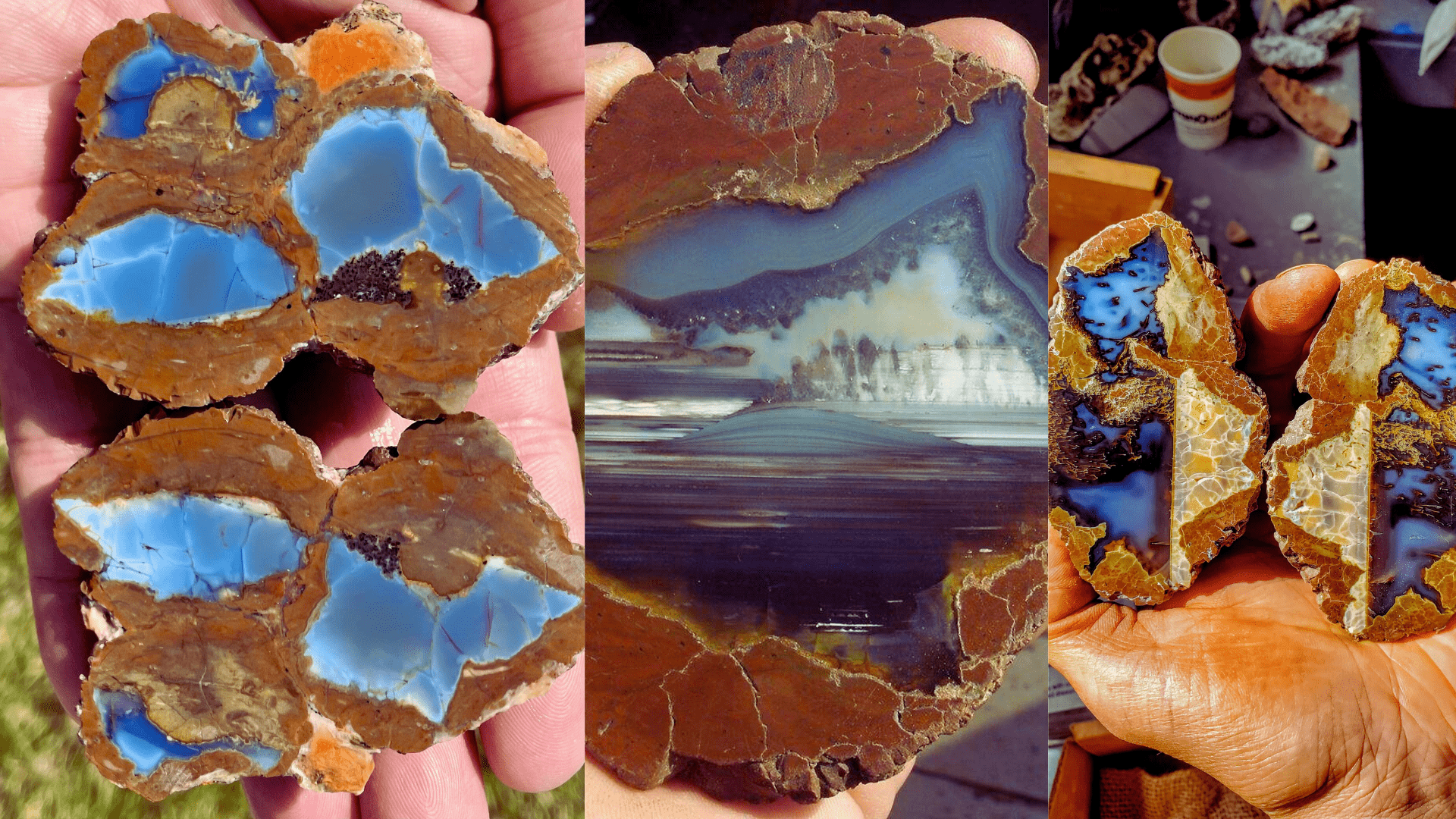Thunder Eggs, often mistaken as mere stones, carry within them a fascinating world far beyond their unassuming exteriors. These geological marvels, also known as lithophysae, are essentially natural time capsules that offer a glimpse into the volcanic activities of yesteryears. Found embedded in volcanic ash or within rhyolite formations, thunder eggs are formed when silica-rich minerals infiltrate gas bubbles within the volcanic rock. Over time, these minerals crystallize, creating the mesmerizing patterns and colors that make each thunder egg unique.
Despite their name, thunder eggs have no connection to thunder or weather phenomena. The name is derived from Native American myths, which often associated these stones with the gods throwing them during thunderstorms. Thunder eggs are not to be confused with geodes, though both share similarities; thunder eggs are typically filled with compact mineral deposits, making them solid, whereas geodes can be hollow inside.
Thundereggs can vary greatly in size, from as small as a marble to larger than a basketball, and their interiors can host an array of crystals such as quartz, agate, or jasper, making them highly sought after by collectors and enthusiasts. Each thunder egg tells a story, not just of its formation, but of the Earth’s volcanic past, capturing the imagination of those who seek to uncover the secrets locked within these natural treasures.
The Science Behind Thunder Eggs
How are Thunder Eggs Formed?
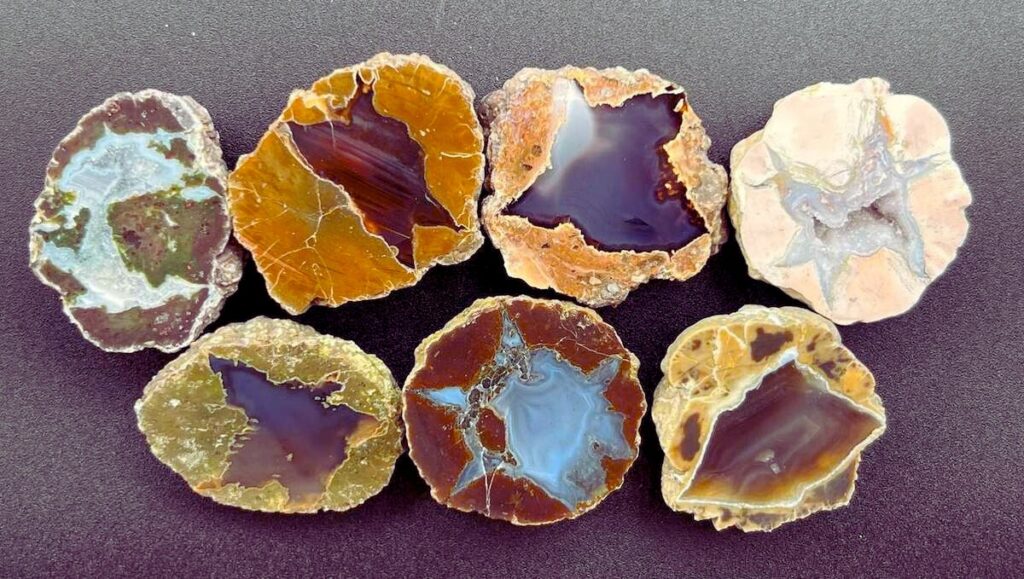
Thunder Eggs, or Thundereggs, are geological marvels formed within rhyolitic volcanic ash layers. Their formation begins with the cooling of silica-rich lava, which contains gas bubbles. Over time, water percolates through the porous rock carrying silica in solution. This silica gradually deposits within the cavities formed by the gas bubbles, eventually crystallizing into the solid center commonly seen in Thunder Eggs. The outer shell of a Thunder Egg is typically composed of harder silicified rock, which may adhere to the nodule, providing a durable exterior. This unique process of formation results in the creation of Thunder Eggs with varied and often beautiful internal structures, including agate, quartz, chalcedony, or opal deposits.
The Difference Between Thunder Eggs and Geodes
Thunder Eggs and Geodes are both geological formations that can contain beautiful crystal structures inside. However, they have distinct differences in their formation and structure:
- Formation Location and Material: Thunder Eggs are formed within rhyolitic volcanic ash layers. They are essentially nodule-like rocks that are similar to filled geodes but have a specific genesis linked to silica-rich volcanic activities. Geodes, however, can form in various types of volcanic and sedimentary rocks and are typically associated with limestone, basalt, or other rock types that contain voids or cavities.
- Formation Process: Thunder Eggs are thought to form in gas pockets within lava, which serve as molds. These pockets are filled with mineral-rich water that deposits silica and other minerals inside, eventually hardening into the solid center characteristic of Thunder Eggs. Geodes form in hollow areas of sedimentary rock or in bubbles in volcanic rock. Over time, mineral-rich water seeps into these cavities and deposits crystals.
- Exterior Appearance: Thunder Eggs usually have a more nodule-like appearance with a rough outer surface. Geodes, on the other hand, may appear more like spherical rocks from the outside but can have a very thin outer layer compared to the size of the hollow cavity inside, which is lined with crystals.
In summary, while both Thunder Eggs and Geodes share a crystalline beauty on the inside, their origins, formation processes, and exterior appearances set them apart.
Where Can You Find Thunder Eggs?
Popular Locations for ThunderEgg Hunting
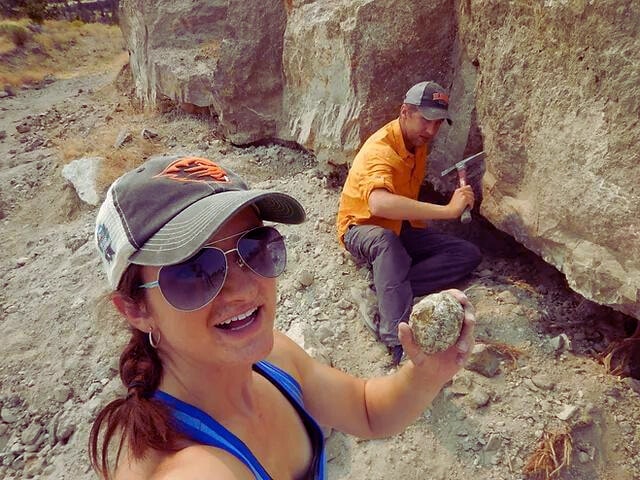
Thunderegg hunting can be a fascinating and rewarding hobby for geology enthusiasts and collectors. Some popular locations known for thunder egg hunting include:
- Oregon, USA: Oregon is renowned for its thunder eggs and even has the thunder egg designated as its official state rock. Specific sites within Oregon, such as the Richardson Rock Ranch, offer designated areas for public hunting.
- Queensland, Australia: Queensland is home to several thunder egg geosites, with Mt. Hay being a notable location. The volcanic areas of Queensland are rich in thunder eggs, offering opportunities for collectors.
- Germany: Certain volcanic regions in Germany are known to house thunder eggs. Areas in the Eifel region, for instance, have been popular sites for finding these geological formations.
- Mexico: Mexico, with its rich volcanic geography, also offers locations where thunder eggs can be found. The states of Chihuahua and Coahuila have reported findings of thunder eggs.
Remember, if you’re planning to go thunderegg hunting, it’s important to research and ensure you have permission to collect on the land you’re visiting. Many sites require fees for digging or have specific regulations to protect the geological and natural resources. Happy hunting!
Tips for Hunting Thunder Eggs
Tools You’ll Need
Thunderegg hunting can be an exciting and rewarding hobby, but it requires some preparation and the right tools. Here’s a brief guide on what you might need:
- Safety Gear: Always start with safety. Wear protective eyewear, gloves, and sturdy footwear. Depending on the location, a helmet might also be advisable.
- Rock Hammer or Geologist’s Hammer: This is essential for cracking open rocks. A rock hammer has a flat end for breaking and a pointed end for chipping.
- Chisels: Chisels can be used in conjunction with the hammer to carefully split rocks without damaging potential treasures inside.
- Backpack or Bucket: You’ll need something to carry your finds as well as your tools as you move around.
- Water Bottle: For washing off potential finds get a better look at them on-site. Hydration for yourself is equally important.
- Field Guide and Maps: Knowing what you’re looking for and where to find it is crucial. A good field guide can help identify thunder eggs and other geological formations.
- First Aid Kit: Always have a basic first aid kit for cuts or scrapes.
Remember, patience and persistence are also key tools in your kit. Happy hunting!
Identifying a Good Spot
When hunting for thunder eggs, identifying a good spot can significantly increase your chances of success. Here’s how to do it:
- Research Geological Maps: Look for areas with rhyolite lava flows, as thundereggs are often found in these regions. Geological maps can help pinpoint these locations.
- Local Knowledge: Talk to local rockhounding clubs, geologists, or experienced collectors. They can provide valuable insights into the best spots to find thunder eggs in your area.
- Scouting: Visit potential sites and look for signs of previous volcanic activity, such as volcanic ash deposits or old lava flows. These areas are prime locations for finding thunder eggs.
- Visual Clues: Keep an eye out for rounded or egg-shaped rocks on the surface. These could be indicators of thunder eggs buried beneath the ground.
- Accessibility: Choose spots that are accessible and legal to collect from. Public lands, rockhound sites, or areas designated for recreational rock collecting are good options.
- Safety Considerations: Prioritize safety when selecting a spot. Avoid areas with unstable terrain, cliffs, or other hazards. Always follow local regulations and obtain any necessary permits before collecting.
By combining these strategies, you can increase your chances of finding thunder eggs and have a rewarding rockhounding experience.
How to Open a Thunder Egg
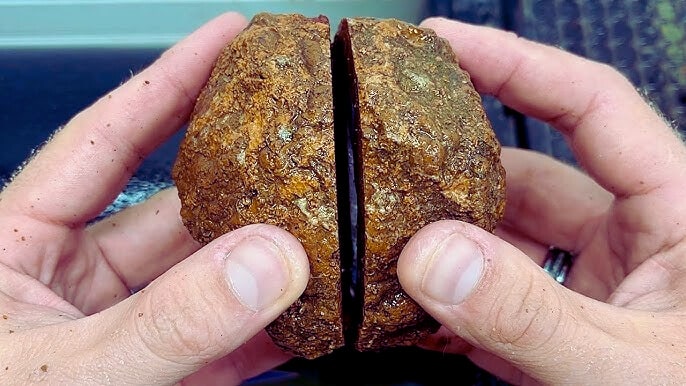
Opening a thunder egg to reveal the crystal surprise inside requires careful handling and the right tools to avoid damaging the precious contents. Here’s a basic guide:
- Identify the Egg’s Natural Axis: Look for the line or band that wraps around the thunder egg. This often indicates the natural division between the two halves.
- Use a Rock Saw: A rock saw with a diamond-tipped blade is ideal for cutting thunder eggs. These saws make precise cuts and reduce the risk of shattering or damaging the egg. If you don’t have access to a rock saw, some gem and mineral shops offer cutting services.
- Cutting the Egg: Secure the thunder egg in a vise or with clamps to keep it steady. Cut along the identified axis, slowly and with steady pressure to ensure a clean cut. It’s crucial not to rush this process to preserve the integrity of the crystals inside.
- Polishing: After cutting, the cut faces can be polished to enhance the visibility of the crystals and the overall appearance of the thunder egg. This can be done using a series of grinding and polishing wheels with progressively finer grits.
- Safety First: Always wear protective eyewear and a dust mask to protect yourself from rock dust and small particles. Additionally, ensure you’re using equipment in a safe and recommended manner.
Remember, the beauty of a thunder egg often lies in its natural form, so the goal is to open it in a way that reveals its inner beauty without altering or damaging it too much.
Cleaning and Displaying Thunder Eggs
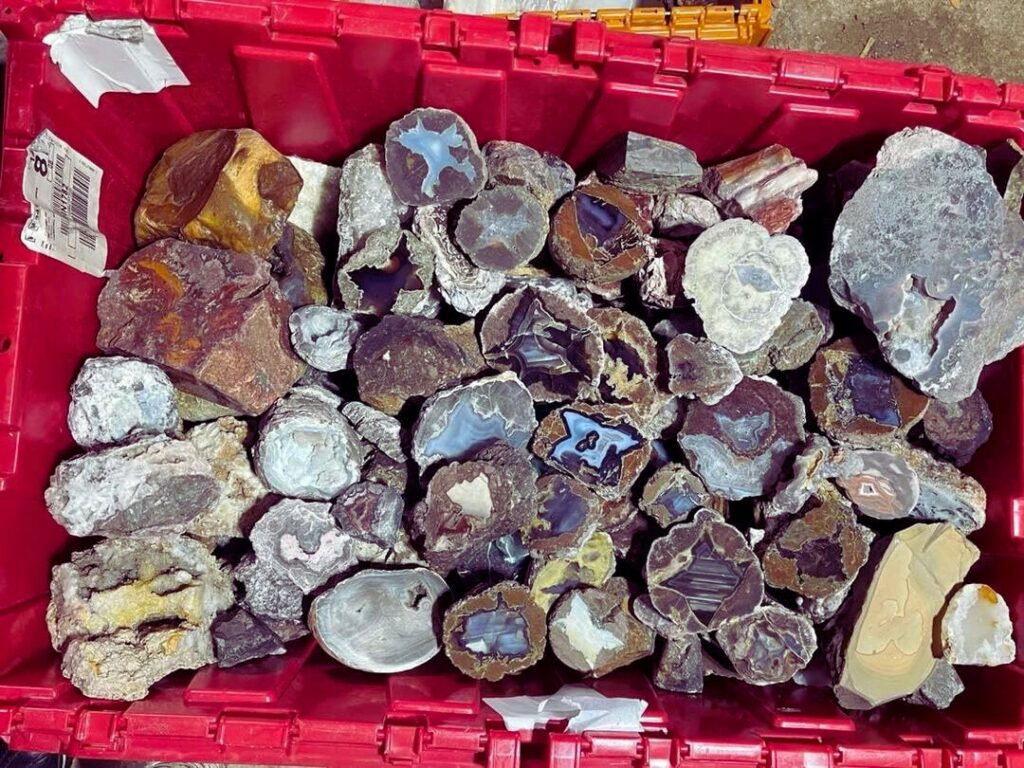
To clean and display thunder eggs effectively, follow these steps to ensure they look their best:
- Cleaning: Begin by washing the thunder eggs in soapy water to remove any dirt or debris. Use a soft brush for tougher grime. Rinse thoroughly with clean water.
- Removing Stains: For stubborn stains, you can soak the thunder eggs in a solution of water and a mild acid like vinegar or oxalic acid (be cautious and follow safety guidelines when handling chemicals). This can help dissolve iron stains and other mineral deposits.
- Drying: After cleaning, dry the thunder eggs completely. A soft cloth can be used to gently dry the surface, or you can let them air dry.
- Polishing: To enhance their appearance, you can polish the cut and polished faces of the thundereggs using a lapidary polishing machine or by hand with polishing compounds and a soft cloth. This step is particularly important if you’ve cut the thunder egg open to reveal the inner crystals.
- Displaying: For display, consider the best orientation that showcases the thunder egg’s unique patterns and colors. Use stands or small display cases designed for minerals and fossils. Labeling each piece with information about its origin, type, and any personal collection notes can add educational value to your display.
- Maintenance: Keep thunder eggs away from direct sunlight to prevent fading. Dust them regularly with a soft, dry cloth. If they begin to look dull, a light polish can restore their shine.
By following these steps, you can ensure your thunder eggs are both preserved and presented in a way that highlights their natural beauty.
The Cultural Significance of Thunder Eggs
Legends and Lore
Thunder eggs, also known as geodes, have fascinated humans for centuries and hold a special place in various cultural narratives and legends. Their mysterious interiors, often filled with beautiful crystal formations, have inspired a range of mythologies and lore.
- Native American Lore: Among some Native American tribes, thunder eggs are believed to be the physical manifestations of the thunder spirits’ displeasure, hence the name. These tribes held the belief that when the gods threw lightning at the earth, thunder eggs were formed at the spots where the lightning struck. They are often considered as protective objects or powerful talismans that could connect one to the Earth’s energies.
- Australian Aboriginal Legends: In Australian Aboriginal mythology, thunder eggs are sometimes associated with the Dreamtime stories, representing the eggs of the mythical Rainbow Serpent. The Rainbow Serpent is a key figure in the creation stories of several indigenous cultures across Australia, and thunder eggs are sometimes seen as physical reminders of the serpent’s power to shape the landscape.
- European Folklore: In some European traditions, geodes (and by extension, thunder eggs) were believed to be petrified bubbles of the dragons’ breath or the eggs of dragons themselves. They were sought after for their supposed magical properties, including healing, protection, and the ability to offer guidance.
- Modern Interpretations: Beyond their historical and cultural significance, Thunder Eggs continue to captivate the modern imagination. They are popular among collectors and enthusiasts of natural history for their unique beauty and the surprise of cracking them open to reveal the hidden crystals inside. They’re also used in metaphysical practices, valued for their perceived energy properties including grounding, balance, and harmony.
The lore surrounding thunder eggs reflects the human fascination with the natural world and the stories we create to explain and give meaning to the mysteries that surround us. Their allure lies not just in their aesthetic appeal but in the rich tapestry of cultural significance that has been woven around them through the ages.
Modern Day Collecting
Thunder eggs, with their intriguing patterns and hidden crystalline beauty, have transcended their natural and cultural origins to become highly valued collectibles in modern times. Their significance today can be appreciated through several lenses:
- Geological Wonder: Collectors often seek thunder eggs for their unique geological features. Formed within rhyolitic volcanic ash layers, each thunder egg is a miniature snapshot of volcanic activity and the natural processes that shape our planet.
- Artistic Inspiration: The stunning patterns and variety found inside thunder eggs make them sought-after items for artists and designers. Each cut reveals a unique natural masterpiece, inspiring creativity across various mediums.
- Cultural Connection: Thunder eggs hold a place in the traditions and legends of various cultures, particularly among Native American tribes who regarded them as the eggs of thunderbirds. Modern collectors often value these stones for their connection to these rich cultural histories.
- Educational Value: For educators and students, thunder eggs serve as tangible lessons in earth science and volcanology. They help illustrate the processes of mineral deposition and nodule formation, making them invaluable educational tools.
- State Symbolism: In regions like Oregon, thunder eggs hold particular significance as state symbols, representing the geological heritage and natural beauty of the area. They are emblematic of Oregon’s rich volcanic history and its diverse geological landscape.
Today’s collectors of thunder eggs are motivated by a blend of aesthetic appreciation, scientific interest, and cultural reverence. The modern collection of these geological treasures is a testament to their enduring allure and the multifaceted significance they hold within our cultural and natural world.
Conclusion
Thundereggs reminds us of the earth’s ability to create beauty in the most unexpected places. Whether you’re a seasoned rockhound or a curious newbie, the hunt for thunder eggs offers adventure, mystery, and the thrill of discovery. Who knows? The next rock you crack open could reveal a world of wonder.
Read also: Why Did Sharona Leave Monk?
FAQs
Q. Do all thunder eggs contain crystals?
Not all thunder eggs contain crystals; some may be filled with agate or other minerals. It’s the surprise inside that makes each one unique!
Q. Are thunder eggs valuable?
While most thunder eggs might not make you rich, rare specimens, especially those with unique patterns or containing precious opals, can be quite valuable.
Q. Can thunder eggs be found anywhere else in the world?
Yes, thunder eggs can be found in volcanic regions across the globe, including Germany, Mexico, and Ethiopia, among others.
Q. How old are thunder eggs?
Thundereggs can be millions of years old, with their formation dating back to ancient volcanic eruptions.
Q. Is it legal to collect thunder eggs?
The legality of collecting thunder eggs varies by location. Always check local regulations before you go hunting to ensure you’re compliant.
